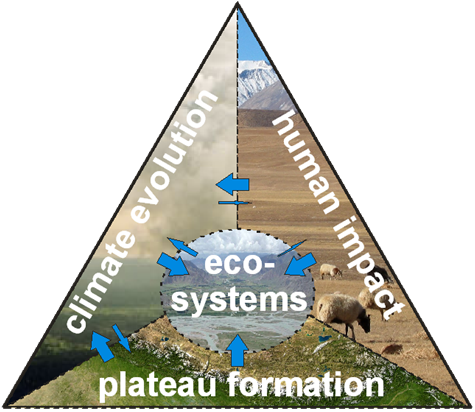Comparative Fertilisation Experiment in the montane belt (Xinghai) and alpine belt (Kema), Tibetan Plateau
Xinghai and Kema 2011
From 07/2011 to 09/2011Staff: Elke Seeber, Sabrina Träger, Kathrin J. Ward
From July to September 2011, a fertilisation experiment was conducted within the framework of the DFG Program SPP 1372 (TiP) in order to determine the effects of fertilisation on the above- and below-ground biomass production on the Tibetan Plateau. Ecologists from the Senckenberg Museum of Natural History Görlitz and the University of Halle worked jointly with Chinese partners of the Institute of Tibetan Plateau Research (ITP) from the Chinese Academy of Science (CAS), the Northwest Institute of Plateau Biology, CAS, Xining and the University of Lanzhou as well as with local people and pasture owners.
 From left to right: Scientists in Xinghai together with the family of the pasture owner, transport of the probes by dunkey, scientists and local people in Kema
From left to right: Scientists in Xinghai together with the family of the pasture owner, transport of the probes by dunkey, scientists and local people in Kema
The experiment was set up at two locations in different altitudinal belts; the montane belt in Xinghai (3400 m asl.) and the alpine belt in Kema (4500 m asl.) and at each altitude there were two vegetation types; a Kobresia pygmaea-dominated rangeland and a grass-dominated pasture. In six replicates, we tested the effects of addition of phosphate, nitrogen, the combination of both and a bio-fertilizer produced of Yak dung against a control during a growing period of one month. Field work included sampling of vegetation relevés and above- as well as below-ground biomass harvest. Soil samples were taken for further laboratory analysis including nutrition analysis. Additionally rain fall, as an important plant growth determining factor, was measured.
In order to test the bio-fertilizer also for agricultural usage in a more controlled and thus reproducible environment we established a pot experiment in a green house in Kema with a local barley cultivar as a model plant. Temperatures inside and outside of the greenhouse were measured by data loggers.
 From left to right: scientists cutting above ground biomass at a Kobresia-dominated site in Xinghai, cages prevent the fertilized plots from grazing at a Stipa-dominated site in Xinghai, Sabrina Träger taking soil samples, pots with germinated barley
From left to right: scientists cutting above ground biomass at a Kobresia-dominated site in Xinghai, cages prevent the fertilized plots from grazing at a Stipa-dominated site in Xinghai, Sabrina Träger taking soil samples, pots with germinated barley
 Grasslands in Xinghai are traditional forage grounds for livestock and wild animals. From left to right: grazing yaks, blue sheep and marmot
Grasslands in Xinghai are traditional forage grounds for livestock and wild animals. From left to right: grazing yaks, blue sheep and marmot
From mid August to mid September an undergraduate student from the University of Marburg carried out experiments for the University of Göttingen in Kema. One task was to continue the measurement of evaporation using lysimeters which had been already used in the experiments in 2010 (for further information: Kema-2010 “Interdisziplinäres Atmosphäre Ökosystem Experiment in Kema, Tibetisches Hochplateau“). Another experiment aimed at reducing precipitation by constructing special roofs, made of Plexiglas to ensure that radiation can pass without interference. Meteorological instruments were installed in the area beneath the roofs, including temperature loggers and rain gauges. The aim was to find out if the area beneath the roofs was heated and what percentage of rain could pass through the roofs. This experiment will be implemented next year to observe Kobresia pygmaea in a situation of reduced precipitation. Furthermore there was an experiment on soil cooling. For this purpose heat pipes were dug into the ground and temperature loggers were installed to log the cooling. In addition temperature loggers were installed at different depths in the ground to investigate the magnitude of the temperature gradient in the ground.
 Experiments carried out by student from Marburg. From left to right: Roof, temperature logger and rain gauges under roofs, heat pipe experiment with temperature loggers
Experiments carried out by student from Marburg. From left to right: Roof, temperature logger and rain gauges under roofs, heat pipe experiment with temperature loggers

